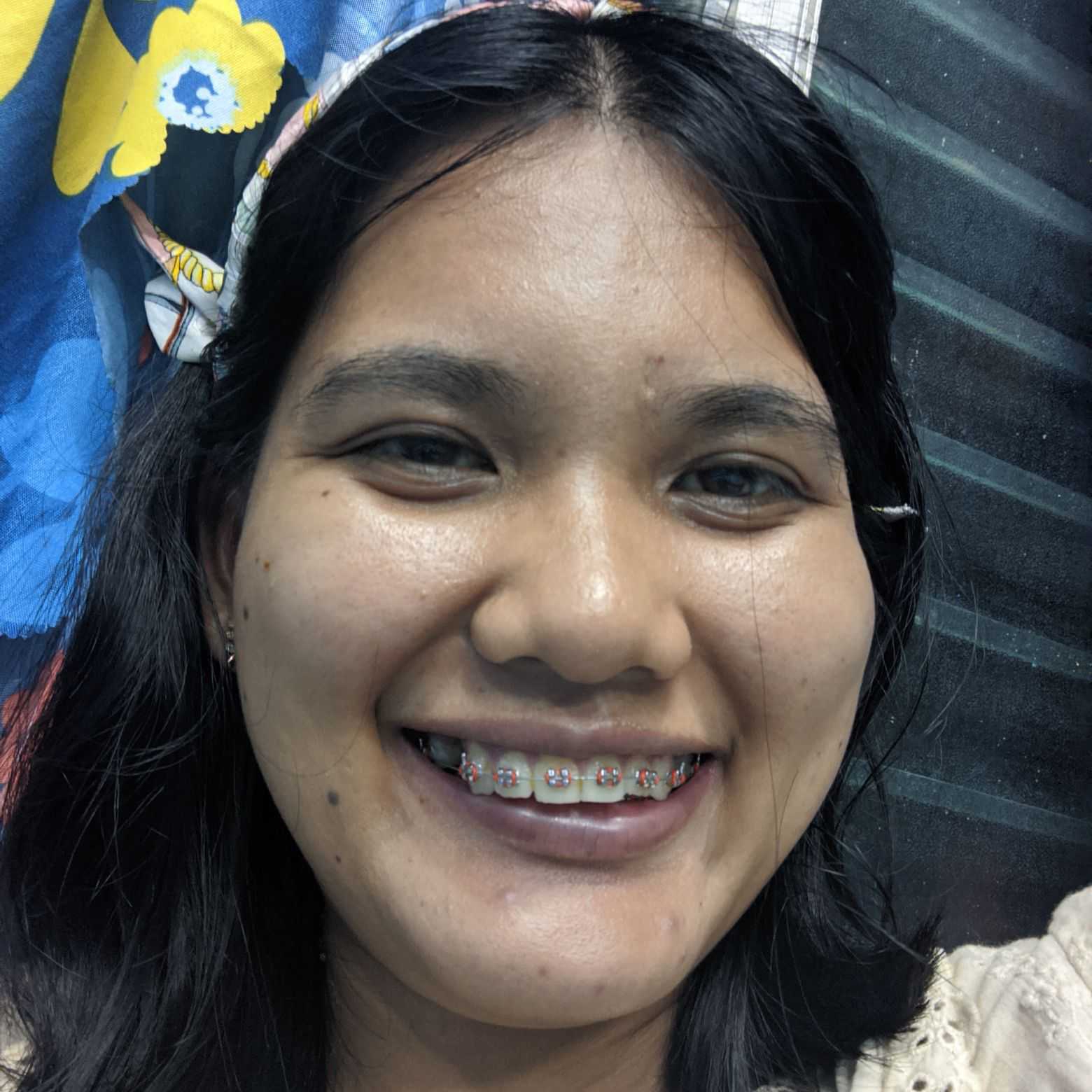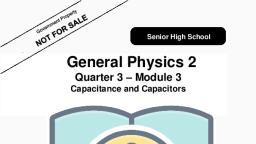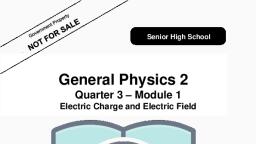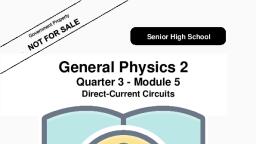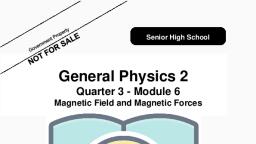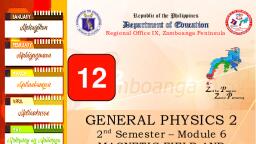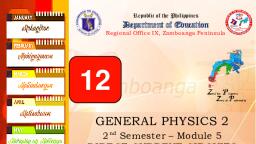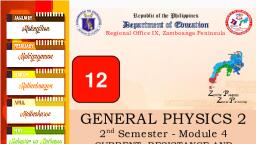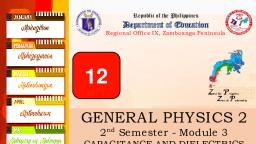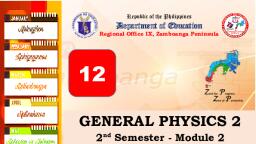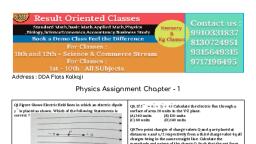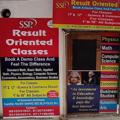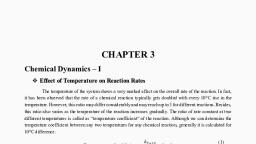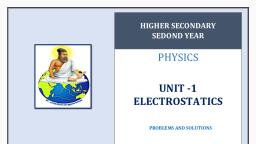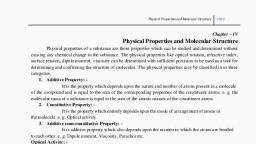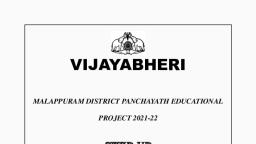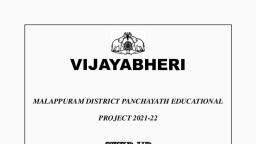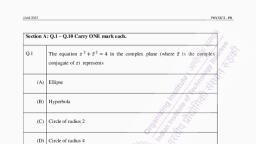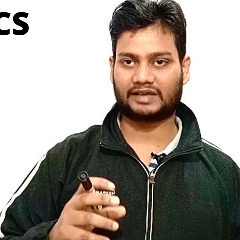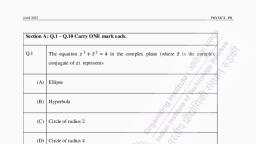Page 1 :
Republic of the Philippines, \, , Department of Education, Regional Office IX, Zamboanga Peninsula, , 12, GENERALPHYSICS 2, 2nd Semester - Module 1, , ELECTRIC CHARGES, AND ELECTRIC FIELDS
Page 2 : General Physics 2 - Grade 12 (STEM), Support Material for Independent Learning Engagement (SMILE), Module 1: Electric Charges and Electric Fields, First Edition, 2021, Republic Act 8293, section176 states that: No copyright shall subsist in any work of the, Government of the Philippines. However, prior approval of the government agency or office, wherein the work is created shall be necessary for the exploitation of such work for a profit. Such, agency or office may, among other things, impose as a condition the payment of royalties., Borrowed materials (i.e., songs, stories, poems, pictures, photos, brand names,, trademarks, etc.) included in this module are owned by their respective copyright holders. Every, effort has been exerted to locate and seek permission to use these materials from their respective, copyright owners. The publisher and authors do not represent nor claim ownership over them., Development Team of the Module, Writer:, , Jeovanny A. Marticion, , Editor:, , Helen M. Ogoc, , Reviewers:, , Helen M. Ogoc, Zyhrine P. Mayormita, , Layout Artist:, , Oliver A. Manalo, , Management Team: Virgilio P. Batan Jr., Lourma I. Poculan, , - Schools Division Superintendent, - Asst. Schools Division Superintendent, , Amelinda D. Montero - Chief Education Supervisor, CID, Nur N. Hussien, , - Chief Education Supervisor, SGOD, , Ronillo S. Yarag, , - Education Program Supervisor, LRMS, , Zyhrine P. Mayormita - Education Program Supervisor, Science, Leo Martinno O. Alejo - Project Development Officer II, LRMS, Joselito S. Tizon, , - School Principal, Dipolog City NHS, , Printed in the Philippines by, Department of Education – Region IX– Dipolog City Schools Division, Office Address:, Purok Farmers, Olingan, DipologCity, Zamboanga del Norte, 7100, Telefax:, (065) 212-6986 and (065)212-5818, E-mailAddress:,
[email protected]
Page 3 :
What I Need to Know, This module will help you in understanding the basic concepts of electric charges, and fields. The topics covered by this module are electric charges. At the end of this, module, you should be able to:, 1. Describe using a diagram charging by rubbing and charging by induction, STEM_GP12EM-IIIa-1;, 2. Explain the role of electron transfer in electrostatic charging by rubbing, STEM_GP12EMIIIa-2;, 3. Describe experiments to show electrostatic charging by induction, STEM_GP12EM-IIIa-3;, 4. Calculate the net electric force on a point charge exerted by a system of point, charges STEM_GP12EM-IIIa-6;, 5. Describe an electric field as a region in which an electric charge experiences a, force STEM_GP12EM-IIIa-7; and, 6. Calculate the electric field due to a system of point charges using Coulomb’s law, and the superposition principle STEM_GP12EM-IIIa-10., , What’s In, In General Physics 1, your journey explored the various fundamental forces found, in nature. Gravity, one of the forces you studied, was examined in a detailed manner, and how it influences the movement of physical bodies., This time, we will be exploring the electromagnetic force, one of nature’s, fundamental forces, which possesses both electric and magnetic force. However, we, need to know how this interaction involves particles with electric charge in, understanding this force. This could also be fundamentally represented by mass. When, an object with mass is accelerated by an applied force, objects with electric charges are, also accelerated by the presence of electric forces., This behavior can be observed when we see lightning strikes the sky, feel the shock, from a metallic surface after scrubbing our shoes across a carpet or when lighter objects, stick with other objects such as dust clinging on a plastic paper., Activity 1: GETTING RECHARGED!, Direction: This is to check what you have learned about electric charges and electric, fields. Circle the letter of the best answer., 1. Two unlike charges_________, A. attract each other, C. neutralize each other, B. repel each other, D. have no effect on each other, 2. Which of the following is not a process of charging?, A. Induction, B. Friction, C. Conduction, D. Convection, 3. Material A is positively charged. When brought near to material B, they attract., Which of the following is true?, A. Material B is negatively charged, C. Material B is uncharged, B. Material B is positively charged, D. Both are uncharged, , 1
Page 4 :
4. Material B has become positively charged after rubbing it with Material A. Which, of the, following statements is correct?, A. Material B loses protons, C. Material A loses proton, B. Material B gains electrons, D. Material A gains electron, 5. What will happen when two unlike charges are brought together? They will _____, A. repel each other, C. attract each other, B. neutralize each other, D. no effect on each other, 6. If you comb your hair and the comb becomes positively charged, then your hair, becomes _________., A. positively charged, C. uncharged, B. negatively charged, D. discharged, For No. 7 & No. 8 study the given Triboelectric series, where moving up means, positive and moving down means negative., 7. Which of the following pairs has the strongest electrical force, Melgi, of attraction?, Xatzki, A. Welcru and Lokfu, C. Xatzki and Melgi, Lofku, B. Zysmu and Melgi, D. Kharmi and Xatzki, Khamri, Welcru, 8. Which of the following would have a negative net charge when, Zysmu, rubbed with Kharmi?, A. Lokfu, B. Welcru, C. Xatzki, D. Melgi, 9. A negatively charged rod is brought near a metal can that rests on a wooden box., You touch the opposite side of the can momentarily with your finger. If you remove, your finger before removing the rod, what will happen to the can?, A. It will be discharged, C. It will become negatively charged, B. it will become positively charged, D. Its charge will remain as it was, 10. Which of the following can be attracted by a positively charged object?, A. Another positively charged object, C. A neutral object, B. Any object, D. No other object, , What’s New, Activity 2: WATER BENDING, Direction: This activity will help you acquire real-life concepts of static electricity., Materials You Need: 3 Styrofoam cups (you can also use 2 paper cups and an inflated, balloon) and a toothpick. Also, this experiment will also require water and someone with, dry and clean hair., 1. Prepare the set-up by pushing the toothpick at the bottom side of the cups. Leave the, toothpick to produce a gentle drop of water after filling the cup. Hold the cup directly, over the second cup. Fill the cup (with a toothpick) with water and check if it is leaking, steadily., 2. Observe the flow of water from the top cup to the cup below. What are your, observations? ____________________________________________________, 3. Rub the third cup on someone with dry hair several times. (This process will help, you in acquiring electrical charges)., 4. Hold the cup (rubbed against dry hair) near the water stream without getting the cup, wet. What happened to the water flow? _______________________________________, _______________________________________________________________Then, slowly move, the cup away from the stream and observe. Did you observe changes? ___________ If, yes, describe the change. _________________________________________________________, , 2
Page 5 :
____________________________________________________________________________________, 5., , Try other objects (such as balloon, paper cup or any material) aside from the, Styrofoam cup and rub it on a dry and clear hair. What objects have you tried?, _____________________________Which of the objects have changed the flow of water?, _______________________________________________________________________________, , What Is It, Electric Charges, The main building block of matter is composed of atoms and molecules. Its, properties are primarily influenced by the electrically charged particles – proton,, electron, and neutron. The table below shows the properties of the charged particles in, terms of mass, charge, and location., , Particle, , Mass, (in terms of kg), , proton, electron, , 9.1093897 x 10-31 kg, 1.6726231 x 10-27 kg, , neutron, , 1.6749286 x 10-27 kg, , Charge, (in terms of Coulomb, (C)), , Location in atom, , +1.60217733 x 10-19 C, -1.60217733 x 10-19 C, , nucleus, outside nucleus, , none, , nucleus, , Materials contain a huge amount of positively charged particles called protons and, negatively charged particles called electrons. When there is an equal number of protons, and neutrons in a matter, the body is electrically neutral. In making a body negatively, charged, electrons are added to a body. On the other hand, a positively charged body, removes electrons., , Number of, Number of, protons, = electrons, , negatively, charged, , positively, charged, , The transfer of electrons from one body to another proves the law of conservation, of charges. These charges are neither created nor destroyed. According to the principle, of conservation of charges, the sum of electric charges of a body within a closed system, is always constant., In understanding electrostatic interactions, we have to keep in mind the following, conventions:, 1. Any charged object can attract a neutral object., , 3
Page 6 :
2. Unlike charges attract, , 3. Like charges repel., , Charging Objects, Materials that allow the movement of electrons from one region to another, are called conductors of electricity, while materials that do not allow the flow of electrons, are called insulators. The majority of the metals are conductors, while nonmetals are, insulators. The electrons can move while protons and neutrons are bound to remain, fixed in the positive nuclei., Charging objects could happen through induction and conduction. These, charging processes can be demonstrated through an electroscope. The electroscope is, composed of a metal knob, metal rod, glass container, and foil (leaf). The small metal, foils are hung at the end of the metal rod. This should freely move since they open after, being charged., When a charged object is placed near the metal knob, this causes the foil to open, up since they are being repelled by the presence of excess charges. The foils drop down, when the charged object is placed away from the electroscope., Metal knob, , Glass, Leaves (foil), Charging by Conduction, , When a negatively charged rod touches, the neutrally charged metal knob, the, knob attracts the electrons making the, leaves negatively charged., , When a positively charged rod touches, the neutrally charged metal knob, the, rod attracts the electrons making the, leaves positively charged., , 4
Page 7 :
Charging by Induction, , When, a, negatively, charged rod is placed, near the knob, the, charges, undergo, polarization., Positive, charges are near the, knob while negative, charges stay away from, the knob. This makes, the foil open up., , Electrons, are, repelled to the Earth, when you touch the, knob or when the, ground, wire, is, connected., This, makes, the, electroscope, positively charged., , When you touch the, knob with a finger or, attach it with ground, wire, the electrons, from, Earth, move, towards the knob, making it negatively, charged., , When a positively, charged rod is placed, near the knob, the, charges, undergo, polarization. Negative, charges are near the, knob while positive, charges stay away, from the knob. This, makes the foil open, up., , Electric Force, Charles Augustin de Coulomb (1736-1806) used a torsion balance in studying, gravitational interaction. He studied the attractive and repulsive forces between charges., He found out that the magnitude of force decreases when the distance of separation, between the charges increases. This is shown by Coulomb’s law as expressed in the, equation below:, |𝑸𝟏 𝑸𝟐 |, 𝑭=𝒌, 𝒓𝟐, where k is proportionality constant 9 x 109, , 𝑁𝑚2, ,, 𝐶2, , Q1 and Q2 and point charges expressed, , in Coulomb (C), r is the distance of separation of two charges expressed in meter (m),, and F is the electrostatic force between the two charges expressed in Newton (N). In SI, units, k is not usually written but as, , 1, 4𝜋∈0, , 𝐶2, , where ∈0 = 8.854 𝑥 109 𝑁𝑚2 . This actually, , complicates the formula but could somehow help when you encounter other formulas., If test charges are placed at some angle with respect to other charges, this, involves computing the x and y components of forces. Recall your previous lessons on, vector resolution and trigonometric identities., Refer to the diagram below:, F, , F, , Fy, Ɵ, , 5, , Fx
Page 8 :
Solving for x component, , Solving for y component, , 𝐹𝑥 = 𝐹𝑐𝑜𝑠𝜃, ∑, , 𝐹𝑦 = 𝐹𝑠𝑖𝑛𝜃, , 𝐹𝑥 = 𝐹1𝑥 + 𝐹2𝑥 + 𝐹3𝑥 + ⋯ + 𝐹𝑛𝑥, , ∑, , Solving for magnitude of resultant force, 2, , 𝐹𝑟𝑒𝑠𝑢𝑙𝑡𝑎𝑛𝑡 = √(∑, , 𝐹𝑦 = 𝐹1𝑥 + 𝐹2𝑥 + 𝐹3𝑥 + ⋯ + 𝐹𝑛𝑦, , Solving for the direction of resultant force, , ∑, 𝜃=(, ∑, , 2, , 𝐹𝑥 ) + (∑, , 𝐹𝑦 ), , 𝐹𝑦, 𝐹𝑥, , ), , The next examples will help you understand the application of Coulomb’s Law., Please prepare your scientific calculator and notebook., Example 1:, Two charges lie on positive x-axis. Charge A (2.0 x 10-9 C) is 2.0 cm from the origin and, Charge B is 4.0 cm from the origin. (-3.0 x 10-9 C). What is the total force exerted by, these two charges on Charge C (5.0 x 10-9 C) located at the origin?, A What is/are, QA = 2.0 x 10-9 C at 𝑟𝐴 = 2.0 𝑐𝑚, given?, QB = -3.0 x 10-9 C at 𝑟𝐵 = 4.0 𝑐𝑚, QC = 5.0 x 10-9 C at 𝑟𝐶 = (0,0), B What is asked? F = ? at Q3, C Are the units, No, distance of separation, r, given should be converted, consistent with from cm to m., the formula?, Thus, r1 = 0.02 m and r2 = 0.04 m., How will you, Q, Q, Q, x, D draw the, 0.01 m, 0.03 m, 0.04 m, problem?, 0.02 m, A, , C, , B, , 0.02 m, 0..04 m, , E, , What strategy, must be, employed?, , In solving the total force experienced by Q C from QA and, QB, forces must be computed individually: FAonC and FBonC., The vector sum of these forces will determine the net force, exerted by QA and QB on QC., , F Solution, Solving for FAonC:, 𝐹𝐴𝐶, , Solving for FBonC:, |𝑄𝐴 𝑄𝐶 |, =𝑘, 𝑟𝐴 2, , 𝑁𝑚2 |(2 𝑥10−9 𝐶)(5 𝑥 10−9 𝐶)|, = 9 𝑥 10, (, ), (0.02 𝑚)2, 𝐶2, 𝑁𝑚2 |(1 𝑥10−17 𝐶 2 )|, = 9 𝑥 109 2 (, ), 𝐶, 4 𝑥 10−4 𝑚2, = 9 𝑥 109 𝑁(2.5𝑥 10−14 ), 𝐹𝐴𝐶 = 2.25 𝑥 10−4 𝑁, The direction of this force lies along the, negative x-component since like charges, repel. Thus, - 2.25 𝑥 10−4 𝑁, 9, , 𝐹𝐵𝐶 = 𝑘, , |𝑄𝐵 𝑄𝐶 |, 𝑟𝐵 2, , 𝑁𝑚2 |(−3 𝑥10−9 𝐶)(5 𝑥 10−9 𝐶)|, = 9 𝑥 10, (, ), (0.04 𝑚)2, 𝐶2, 𝑁𝑚2 |(1.5 𝑥10−17 𝐶 2 )|, = 9 𝑥 109 2 (, ), 𝐶, 1.6 𝑥 10−3 𝑚2, = 9 𝑥 109 𝑁(9.375𝑥 10−15 ), 𝐹𝐵𝐶 = 8.44 𝑥 10−5 𝑁, The direction of this force lies along the, positive, x-component, since, unlike, charges attract. Thus, 8.44 𝑥 10−5 𝑁, 9, , 6
Page 9 :
QC, , ∑, G, , FBon, , QB, , 𝐹 = 𝐹𝐴𝐶 + 𝐹𝐵𝐶 = (−2.25 𝑥 10−4 𝑁) + (8.44 𝑥 10−5 𝑁) = −1.41 𝑥 10−4 𝑁, What is the, conclusion?, , Therefore, the magnitude of total force experienced by QC from, QA and QB is 1.406 x 10-4 N directed to the left., , Example 2:, Two point charges are located in xy coordinate system. A charge 2.00 𝑥 10−9 𝐶 is, located at (0,4.00 cm) and the other charge −3.00 𝑥 10−9 𝐶 is located at (3.00 cm,, 4.00 cm). If the third charge 5.00 𝑥 10−9 𝐶 is placed at origin, find the resultant force, at the third charge., A What is/are, Q1 = 2.0 x 10-9 C at 𝑟1 = (0,4), given?, Q2 = -3.0 x 10-9 C at 𝑟2 = (3,4), Q3 = 5.0 x 10-9 C at 𝑟3 = (0,0), B What is asked? F = ? at Q3, C Are the units, No, the distance of separation, r, given should be, consistent with converted from cm to m., the formula?, Thus, r1 = (0 m, 0.04 m), r2 = (0.03 m, 0.04 m) and, r3 = (0,0 m), D How would you, Solving for unknown (c=?), draw the, Q1, using Phytagorean, Q2, theorem:, problem?, 0.03 m, , b = 0.03 m, (opposite), , 0.04 m, , a = 0.04, (adjacent), , c=?, , Ɵ, , 36.87°, , 0.05 m, (hypotenuse), , Solving for unknown (Ɵ = ?), using trigonometric identities:, , Q3, , Locating the individual forces through a diagram, Q1, , Q2, , F2on3, x-component, , F2on3, 36.87°, y-component, , F2on3, , F2on3, , Q3, , E, , What strategy, must be, employed?, , F1on3, F1on3, , The forces experienced by Q3 from Q1 and Q2 must be computed, individually. However, x and y components must be determined, first. For instance, F2on3 has x and y components. The x, component will be calculated by multiplying the magnitude of, F2on3 by sinƟ. On the other hand, y component will be calculated, by multiplying the magnitude of F2on3 by cosƟ. For F1on3, x, component is zero since it lies along y component., , 7
Page 12 :
A, B, C, , D, , What is/are, given?, What is asked?, Are the units, consistent with, the formula?, How would you, draw the, problem?, , q1 = +6.00.0 x 10-9 C at 𝑟1 = (0.800 𝑚, 0.600 𝑚), q2 = -2.00.0 x 10-9 C at 𝑟2 = (0.800 𝑚, 0 𝑚), E = ? at (0,0), Yes, given values have correct SI units., , Solving for unknown, (c=?) using Phytagorean, theorem:, , Q1, c=?, , 1m, (hypotenuse), , Ɵ, , 53°, , 0.6 m, b = 0.03 m, (opposite), , Solving for unknown (Ɵ = ?), using trigonometric, identities:, , 37°, Q2, , 0.8 m, , Review field of, charges, , a = 0.04, (adjacent), , Locating the individual electric fields at (0,0):, , E2, E1, , 53°, , E1y, 53°, , E1x, E, , What strategy, must be, employed?, , The electric fields experienced in origin (0,0) must be, computed individually. Furthermore, x and y components, must be solved for each E1 and E2. We then calculate the, magnitude and direction of the resultant electric field., , F Solution, (1) Solving for F1on3:, , (2) Solving for E2:, , |Q1 |, E1 = k 2, r1, 2 |(6, Nm, x10−9 C)|, = 9 x 109 2 (, ), (1 m)2, C, Nm2 |(6 x10−9 C)|, = 9 x 109 2 (, ), C, 1m2, = 9 x 109 N(6x 10−9 ), N, E1 = 54 C (outward direction), , (3) Solving for x, y components E1x =, N, 54 C (sin 53°), , E1y = 54, , = −43.126, , N, C, , (along –x-axis), , |𝑄2 |, 𝑟2 2, 2 |(−2, 𝑁𝑚, 𝑥10−9 𝐶)|, = 9 𝑥 109 2 (, ), (0.8 𝑚)2, 𝐶, 𝑁𝑚2 |(−2 𝑥10−17 𝐶)|, = 9 𝑥 109 2 (, ), 𝐶, 0.64𝑚2, = 9 𝑥 109 𝑁(−3.125 𝑥 10−17 ), 𝑁, = 28.125 𝑁 𝐶, 𝐸2 = 𝑘, , 𝐹23, , The electric field is directed towards the, positive x-axis since it is a negative, charge (inward direction of field)., (4) Solving for magnitude and direction, of the resultant force, 2, , N, (cos 53°), C, , 𝐹𝑅 = √(∑, , N, = −32.498 (along – y axis), C, N, E2x = 28.125, C, , 𝐹𝑥 ) + (∑, , 2, , 𝐹𝑦 ), , = √(−15.001 𝑁/𝐶)2 + (−32.498 𝑁/𝐶)2, 𝐹𝑅 = 35.79 𝑁/𝐶, , 10
Page 13 :
N, , E2y = 0 C since it lies along x-axis, x component, E1, E2, Sum, G, , N, −43.126 C, N, 28.125 C, N, −15.001 C, , What is the, conclusion?, , ∑, 𝜃=(, ∑, , 𝐹𝑦, 𝐹𝑥, , ) = 𝑡𝑎𝑛−1 (, , y component, -32.498, , −32.498 𝑁/𝐶, ), −15.001 𝑁/𝐶, , = 65.22°, , N, C, , 0, −32.4898, , N, C, , Therefore, the magnitude and direction of the resultant force, 𝑁, , is 35.79 𝐶 , 65.22°., , You can verify the magnitude and direction of the resultant force using a, graphical method for vector analysis., Electric Flux, The relationship between electric charge and electric field was also formulated, alternatively in Gauss’s law (Karl Friedrich Gauss 1777-1855). This is logically, equivalent to Coulomb’s law, but this was easier to use in finding electric field for, symmetrical charge distribution., Gauss’s law general statement is expressed as, 𝜙𝐸 = 𝐸𝐴cosƟ, where is the electric flux, , 𝑁𝑚2, ,, 𝐶, , E is the magnitude of electric field expressed in, , 𝑁, 𝐶, , , Ɵ is, , the angle between the normal line of the surface and electric field lines. and A is the, area of a given surface expressed in m2., Electric flux refers to the amount of electric field lines penetrating a given, surface. The electric flux is maximum if the electric field lines are perpendicular to the, surface or parallel to the normal line of the surface. The electric flux is zero when the, electric field line is parallel to the surface or perpendicular to the normal line of the, surface. At a given angle, the electric flux is directly proportional to the component of, the electric field lines., , Example 4:, A point charge 𝑞 = 8.00 𝑥 10−9 𝐶 is at the center of the cube with sides of length 0.200, m. What is the electric flux through one of the six faces of the cube?, A, B, , What is/are, given?, What is asked?, , q = +8.00 x 10-9 C ; 𝑠 = 0.200 𝑚, 𝞍 = ? at one of the faces of the cube, , 11
Page 14 :
C, , D, , Are the units, consistent with, the formula?, How would you, draw the, problem?, , Yes, given values have correct SI units., , c = 0.141, , c = 0.283, , 0.200 m, , 0.200 m, , 0.200 m, , E, , F, , What strategy, must be, employed?, Solution, , 0.200 m, , Hence, the distance from the charge to the surface of the cub, is 0.141 m, Using Gauss’s law, substitute E with formula for Electric Field, 𝒒, , 𝑬 = 𝒌 𝒓𝟐, 2, −9, 𝑞, 𝑁𝑚 |(8 𝑥10 𝐶)|, 9, 𝐸 = 𝑘 2 = 9 𝑥 10 2 (, ), (0.141 𝑚)2, 𝑟, 𝐶, , 9, , = 9 𝑥 10, , 𝑁𝑚2, 𝐶2, , |(8 𝑥10−9 𝐶)|, 𝑁𝑚2, 9, (4.02 𝑥 10−7 ), (, ) = 9 𝑥 10, 2, 2, 0.0199 𝑚, , 𝐶, , 𝐸 = 3,621.55 𝑁/𝐶, 𝐴 = 𝑠 2 = (0.200 𝑚)2 = 0.04 𝑚2, 𝑁, , 𝑁𝑚2, , 𝐶, , 𝐶, , 𝜙𝐸 = 𝐸𝐴𝑐𝑜𝑠Ɵ = 3,621.55 (0.04 𝑚2 ) = 144,862, G, , What is the, conclusion?, , Therefore, the electric flux at any surface is 144,862, , 𝑁𝑚2, 𝐶, , What’s More, Activity 3: QUALITATIVE PROBLEMS, Direction: Solve the following problems as directed. You may show your solution on a, separate sheet of paper, (1) Two spheres of equal mass and equal charge are separated at a distance r. (a), Derive an expression for the quantity of charge that must be on each sphere so that, the spheres are in an equilibrium where attractive and repulsive forces are balanced., , (b) How would doubling the distance between spheres affect the expression for the, value of q from the previous problem. Explain., , _____________________________________________________________________________, _____________________________________________________________________________, ____________________________________________________________________, , 12
Page 15 :
(2) How would you draw the electric field lines given the test charges below:, , (3) Coulomb’s law and Newton’s law of gravitation are similar in structure. Can Gauss’s, law be applied to gravitational fields? _________If so, what changes are, needed?____________________________________________________________________________, __________________________________________________________________________, , What I Have Learned, Activity 4: QUANTITATIVE PROBLEMS, Direction: Write your answers on a separate sheet of paper. You may also consult, your Physics teacher., Three charged spheres are at the positions shown in the figure., (a) Find the net electrostatic force at sphere B., (b) Find the net electric field at (4,-3), , 4 cm, , 4.5µC, A, , 8.2 µC, B, , 3 cm, , 6.0µC, , C, , Scoring Rubric, Criteria, 3, Physics, The approach is, Approach, appropriate and, complete, , Procedure, , Description, , Mathematical and, logical procedures, are clear,, complete, and, connected, Diagrams and, symbols used are, appropriate and, complete, , 2, The approach, contains minor, errors, , Mathematical, and logical, procedures are, missing/contain, errors, Parts of the, diagrams and, symbols contain, errors, , 13, , 1, Some of the, concepts and, principles are, missing or, inappropriate, Most of the, mathematical and, logical procedures, , 0, The solution, doesn’t indicate, an approach, , Most of the parts of, the diagrams and, symbols are not, useful, , The entire, visualization is, wrong or did, not include, visualization., , All procedures, are incomplete, and contain, errors
Page 16 :
What I Can Do, Activity 5. BUILDING CONCEPT MAP, Direction: Create a concept map out from the things you have learned from this module., You can use words, terms, phrases, or formulas in connecting these concepts. Refer to, the scoring guide below:, Mueller’s Classroom Concept Rubric, Legible (easy to, read), Accurate (concepts, were used, accurately), Complete, (sufficient number, of relevant concepts, and relationships), Sophisticated, (finding meaningful, connections, between relevant, concepts), , No (0-1), , Yes (2), , Many inaccuracies, (0-2), , A few inaccuracies, (3-4), , No inaacuracies (5), , Limited use of, concepts, (0-2), , Some use of concepts, (3-4), , Sufficient number, of concepts, (5), , Little or none, (0-1), , Few meaningful, connections, made (2-4), , Some, meaningful, connections, made (5-7), , Meaningful, and original, insights, demonstrated, (8), , Assessment, Direction: Write the letter of your choice in the space provided., ______1.The diagram below shows the behavior of the electroscope before and after a, positively charged rod is placed near the electroscope knob. This tells us that the, movement of electrons is from ______., , a.rod to leaves, b.leaves to knob, , c.knob to leaves, then back to knob, d.leaves to knob, then back to leaves, , _____2.A glass rod was positively charged when rubbed with a silk cloth. The net, positive charge is accumulated because the glass rod, a.loses protons, c.gains electrons, b.loses electrons, d.loses electrons, _____3.Gravitational forces and electric forces are both, a.forces with attractive and repulsive behaviors, b.indirectly proportional to the square root of separation between bodies, c.directly proportional to the product of the masses and charges, d.decreasing when the distance between two bodies is decreasing, , 14
Page 17 :
_____4.At which point is the electric field strength strongest?, , A, , D, , C, B, , _____5.Three spheres were brought together. When Spheres A and B are brought, together, they attract. When spheres B and C are brought together, they also, repel. Which of the following is true?, a.Spheres A & C have same signs, c.Spheres A & C have opposite signs, b.Spheres B & C have same signs, d.Spheres A & B have similar signs, _____6.The first object has a charge of +3nC, and the second object has a charge of 6, nC. Which is true about the electric forces between these objects?, , a.F1on2= 2F2on1, , b.3F1on2= 6F2on1, , c.-6F1on2=2F2on1, , d.F1on2=F2on1, , For Nos. 7 to 9, refer to the diagram below:, , _____7. A positively charged rod was brought near to a metallic plate; what is the type, of charge induced along the side facing the rod?, a.positive, b.negative, c.netural, d.depends on number of charges, _____8.If the positively charged rod was touched on the neutral metallic plate, what is, the charge of the plate?, a.same, b.negative, c.positive, d.depends on number of charges, _____9.After the positively charged rod is placed near the plate, a grounded wire was, attached. What is the charge of the plate after the wire is removed?, a.negative, c.neutral, b.positive, d.depends on number of charges, _____10.The electric flux through the surface at the right is ____, η, a.zero, c.positive, b.negative, d.unknown, _____11.A test charge produced an electric field, E, at point 3 m away, from the charge. The point where the field is half its original values is located at, a.1.5 m from the charge, c.4.5 m from the charge, b.6 m from the charge, d.at the point of charge, _____12.The electric field of a body is directly related to its, a.momentum, b.kinetic energy, c.potential energy, , d.charge it carries, , _____13.Charge q1 (26.0 µC) and q2 (-47.0 µC) experienced an electrostatic force of 5.70, N between them at a distance of ____, a.1.39 m, b.1.93 m, c.2.14 x 10-19, d.1.464 x 10-8, _____14.How many electrons have been removed from a positively charged particle if it, has a net charge of 5 x 10-9 C?, a.5 x 10-9 electrons, c.1 x 10-8 electrons, -9, b.2.5 x 10 electrons, d.incomplete information, , 15
Page 18 :
_____15.A sphere of radius 0.05 m has a charge of 2.0 nC. The charge is said to be, located at the center of the sphere. The magnitude of electric field inside the, surface is, a.zero, c.thrice the original value, b.twice the original value, d.half the original value, , Additional Activities, Activity 6. SOCIAL CONTEXT, Direction: The community is a rich source for learning opportunities in electrostatics., Choose one from the following suggested activities in understanding the importance, and utilization of electrostatics in our daily lives:, 1. Ask, a, local, weather, forecaster/Science, teacher/physicist/electrician/engineer through phone calls or, interview through Zoom, Google Meet, or Messenger and inquire (with, supervision from your parents/guardian/learning facilitator) about, lightning, lightning safety, and lightning rods., 2. Conduct simulations on electrostatics, electric fields, Gauss’s law using, online sources. From this, write a short reflection. Refer to any sites, below:, - https://phet.colorado.edu/en/simulation/charges-and-fields, - https://www.falstad.com/emstatic/, - http://web.mit.edu/viz/soft/visualizations/DLIC/doc/simulations/ex, periments/electrostatics/package-summary.html, - https://javalab.org/en/category/electricity_en/static_electricity_en/, 3. Suppose you are to demonstrate a trick to kids using electrostatic, charging. How will you demonstrate the trick? List down the materials, (preferably available at home), step-step procedures, and brief, explanation of how this trick works., , 16
Page 19 :
Answer Key General Physics 2 Module 1, Activity 1: Getting, Recharged, 1. A, 2. D, 3. A, 4. A, 5. A, 6. B, 7. D, 8. C, 9. B, 10. C, , Activity 2: Water Bending, 2. vertical, thin, unbroken stream of water, 4. the stream of water was bent towards the cup; yes, (there should be changes); the stream went back to its, original flow, 5. answers may vary; the influence of charged objects to, water bending may vary depending on their ability to, gain or lose charges, , Activity 3. Qualitative Problems, , Activity 4. Quantitative Problems, , 17
